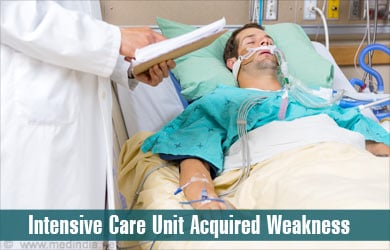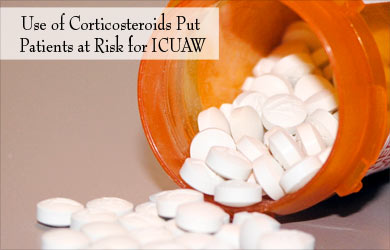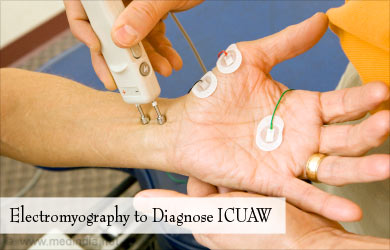- Intensive care unit-acquired weakness. Continuing Education in Anaesthesia, Critical Care & Pain, January 6, 2012. (doi:10.1093/bjaceaccp/mkr057)
- Herridge MS, Cheung AM, Tansey CM et al. One-year outcomes in survi- vors of the acute respiratory distress syndrome. N Engl J Med 2003; 348: 683–93
- Latronico N, Fenzi F, Recupero D et al. Critical illness myopathy and neuropathy. Lancet 1996; 347: 1579–82
What is Intensive Care Unit Acquired Weakness?
Intensive Care Unit Acquired Weakness (ICUAW) is general muscle weakness that develops during the course of ICU admission in patients in whom no plausible cause other than critical illness can be figured out. ICUAW is a frequent problem affecting critically ill patients who have to remain in an ICU for long.
Patients with ICUAW are further classified into those with critical illness polyneuropathy (CIP), critical illness myopathy (CIM), or critical illness neuromyopathy (CINM).

Who are at Risk of ICUAW?
Patients at risk of developing ICUAW include:
- Those with severe infection, i.e. sepsis, and the ones in a related state of shock due to sepsis
- Those who have developed multi organ failure
- Those who have been on bed rest for long
- Those who have been on mechanical ventilatory support for long
- Those with uncontrolled blood sugar levels during ICU stay
Other risk factors will include:
- Age
- Female gender
- Severity of illness on admission
- Abnormal features of blood such as low levels of albumin increased osmolarity
- Parenteral nutrition: getting nutrition through veins (intravenous nutrition)
- Renal replacement therapy: a procedure similar to dialysis
- Use of drugs belonging to classes called corticosteroids, vasopressors, neuromuscular blocking agents and aminoglycosides

What Causes ICUAW?
The exact cause of ICUAW is unknown; it is multifactorial for sure; a large number of factors play together to affect the muscles and nerves. The underlying factors for CIP, CIM, and CINM overlap. CIP is thought to be a manifestation of failure of the peripheral nervous system.
Probable causes for ICUAW maybe:
- Reduced oxygen and nutrient delivery to nerves
- Poor utilization of oxygen and energy
- Toxins that damage the neurons - possible candidates include substances called lipopolysaccharides and IL2-R
- Muscle atrophy: poor availability of proteins and increased cell death can lead to atrophy of the muscles leading to muscle weakness
- Impaired blood glucose levels can also damage nerves
What are the Clinical Features of ICUAW?
Patients with ICUAW are categorized into CIP, CIM, and CINM. The clinical features of all the three entities overlap.
ICUAW presents beyond the first week of ICU stay with patients having suffered from multiple days of severe systemic inflammation, multiorgan failure, or have been managed with high cumulative dosages of drugs belonging to the classes of corticosteroids and/or neuromuscular blocking agents.
Features will include:
- Generalized weakness of muscles
- Facial grimacing is intact, but the patient won’t move his/her limbs
- Muscles that move the eyes (extraocular muscles) are usually unaffected
- Wasting/ atrophy of muscles

- Inability to breathe on their own: patients may need the support of a mechanical ventilator
- Altered sensations. Sensory system may be intact in some cases
What Investigations can Help to Diagnose ICUAW?
The first step in the diagnosis of ICUAW is ruling out every other cause for muscle weakness. Patients who develop weakness at the onset of their illness are investigated for other specific causes (disease like Guillain–Barre ì syndrome, Myasthenia Gravis, Lambert–Eaton syndrome, myopathy/ myositis, disease of the spinal cord, drug-induced conditions).
A neurologist is consulted and detailed workup is done for these patients:
- Blood tests (which include electrolytes, creatine kinase, erythrocyte sedimentation rate, auto-antibodies)
- Lumbar puncture - a procedure where the cerebrospinal fluid, the fluid that surrounds the brain and spinal cord, is sampled for tests
- Neurophysiological assessment (which includes nerve conduction studies, electromyography)
- A magnetic resonance scan (MRI) of the brain/spinal cord
Patients who develop weakness after a sustained period of illness fall under the spectrum of CIP, CIM and CINM. Specific tests ordered will include:
- Levels of creatine kinase
- Study of cerebrospinal fluid
- Nerve conduction studies
- Electromyography

- Direct muscle stimulation studies
- Muscle biopsy
- Nerve biopsy
How can we Treat ICUAW?
Unfortunately, no intervention has been showed to improve the outcome from ICUAW. Supportive care and symptomatic management are all that can be done. Prevention of ICUAW is the dictum. Attention should be shifted to optimizing the rehabilitation for patients once they develop this condition.
Is ICUAW Preventable?
Minimization of risk factors (previously discussed) is the only effective tool we have in our hands to prevent ICUAW. Multiple studies are being done to explore the options available.
Maintenance of optimum blood sugar levels in ICU patients is important. The ideal target for blood glucose is however controversial. While some studies advocate intensive therapy with insulin, others advise a more liberal control of sugar levels.
Electrical muscle stimulation to lower limb muscles may be helpful, suggest studies. But conclusive evidence is still awaited.
What is the Prognosis for ICUAW?
ICUAW is associated with longer ICU and hospital lengths of stay and increased hospital mortality. Patients require longer duration of ventilator support. Mortality associated with ICUAW is high, nearly 45% of those patients diagnosed with the condition may die during hospital admission. For those who survive, almost all patients demonstrate improvement over time. 68% of the patients gain complete functional recovery.
How can Patients with ICUAW be Rehabilitated?
Minimization of inactivity and initiation of the rehabilitation process within the ICU are vital steps. Physical activity, mobilization, and exercise therapy may be commenced in the ICU once the patients are stabilized.
The role of phased physical and mobilization therapy has been studied. This involves:
- Passive and active movements of limbs to begin with, followed by sitting, standing and finally walking
- Occupational therapy: giving necessary training in performing activities such as washing, grooming, etc.
- Electrical stimulation of muscles
- Self-help rehabilitation manuals
Who Treats Patients with ICUAW?
Experts in critical care medicine are the ones who primarily take care of ICUAW. The team usually involves the anesthesiologist, experts in internal medicine, pulmonologists, physical therapist, dietician and the nurses.






